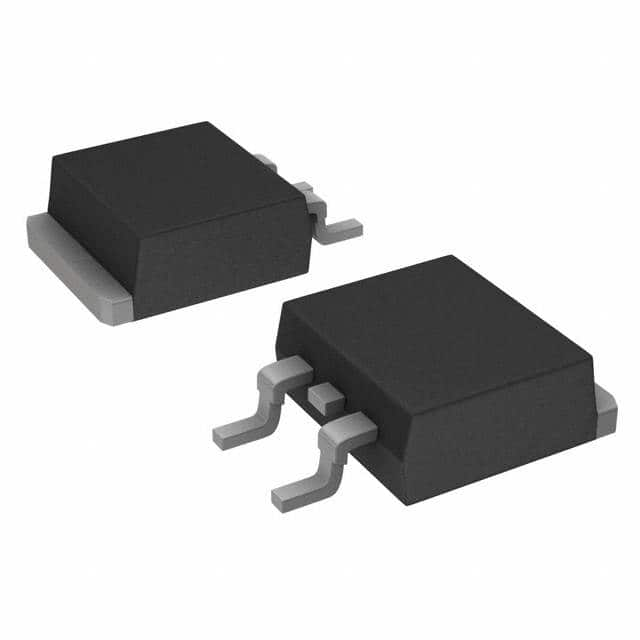IRFBC40LCS
Product Overview
The IRFBC40LCS belongs to the category of power MOSFETs and is commonly used in electronic circuits for switching and amplification purposes. This component is characterized by its high voltage and current handling capabilities, making it suitable for a wide range of applications. The IRFBC40LCS is typically packaged in a TO-220AB package and is available in various quantities to meet different project requirements.
Specifications
- Voltage Rating: 600V
- Continuous Drain Current: 4.2A
- RDS(ON): 1.5Ω
- Package Type: TO-220AB
- Quantity Options: Available in reels or individual units
Detailed Pin Configuration
The IRFBC40LCS features a standard TO-220AB pin configuration with three pins: 1. Gate (G) 2. Drain (D) 3. Source (S)
Functional Features
- High voltage capability
- Low on-resistance
- Fast switching speed
- Low gate drive power required
Advantages and Disadvantages
Advantages
- Suitable for high-power applications
- Low conduction losses
- Minimal heat generation
Disadvantages
- Gate capacitance may lead to slower switching at higher frequencies
- Sensitive to electrostatic discharge (ESD)
Working Principles
The IRFBC40LCS operates based on the principles of field-effect transistors, where the voltage applied to the gate terminal controls the flow of current between the drain and source terminals. By modulating the gate voltage, the MOSFET can effectively switch on and off, allowing for efficient control of power flow in electronic circuits.
Detailed Application Field Plans
The IRFBC40LCS finds extensive use in various applications, including but not limited to: - Switching power supplies - Motor control - Audio amplifiers - LED lighting systems - DC-DC converters
Detailed and Complete Alternative Models
Some alternative models to the IRFBC40LCS include: - IRFBC40LC - IRFBC40 - IRFBC40G
In summary, the IRFBC40LCS power MOSFET offers high voltage and current handling capabilities, making it suitable for diverse applications in electronic circuits. Its low on-resistance and fast switching speed contribute to its efficiency, although considerations should be made for gate capacitance and ESD sensitivity. With its wide range of applications and availability of alternative models, the IRFBC40LCS remains a versatile choice for power management in electronic systems.
Word count: 346
Seznam 10 běžných otázek a odpovědí souvisejících s aplikací IRFBC40LCS v technických řešeních
What is the IRFBC40LCS?
- The IRFBC40LCS is a power MOSFET transistor designed for high-speed switching applications in electronic circuits.
What are the key specifications of the IRFBC40LCS?
- The IRFBC40LCS has a maximum drain-source voltage of 600V, a continuous drain current of 4.2A, and a low on-resistance for efficient power handling.
In what types of technical solutions can the IRFBC40LCS be used?
- The IRFBC40LCS is commonly used in applications such as motor control, power supplies, inverters, and other high-frequency switching circuits.
What are the advantages of using the IRFBC40LCS in technical solutions?
- The IRFBC40LCS offers low on-resistance, fast switching speeds, and high reliability, making it suitable for demanding applications.
How does the IRFBC40LCS compare to similar components in terms of performance?
- Compared to similar components, the IRFBC40LCS offers competitive performance in terms of efficiency, speed, and reliability.
Are there any specific considerations for driving the IRFBC40LCS in a circuit?
- It's important to ensure proper gate drive voltage and current to fully utilize the performance of the IRFBC40LCS and prevent damage due to overvoltage or overcurrent conditions.
Can the IRFBC40LCS be used in high-temperature environments?
- Yes, the IRFBC40LCS is designed to operate reliably in high-temperature environments, but thermal management should still be considered for optimal performance.
What are the typical failure modes of the IRFBC40LCS?
- Common failure modes include overvoltage breakdown, overcurrent damage, and thermal stress, so proper protection and heat dissipation measures should be implemented.
Is the IRFBC40LCS suitable for automotive applications?
- Yes, the IRFBC40LCS can be used in automotive applications, but it's important to ensure compliance with automotive-grade standards and requirements.
Where can I find detailed application notes and reference designs for using the IRFBC40LCS in technical solutions?
- Detailed application notes and reference designs for the IRFBC40LCS can typically be found in the product datasheet, manufacturer's application guides, and online technical resources.


